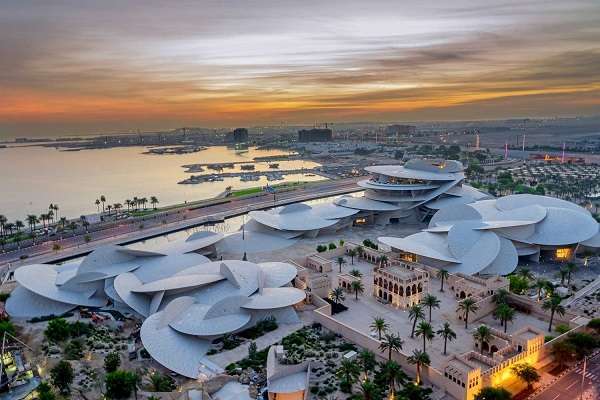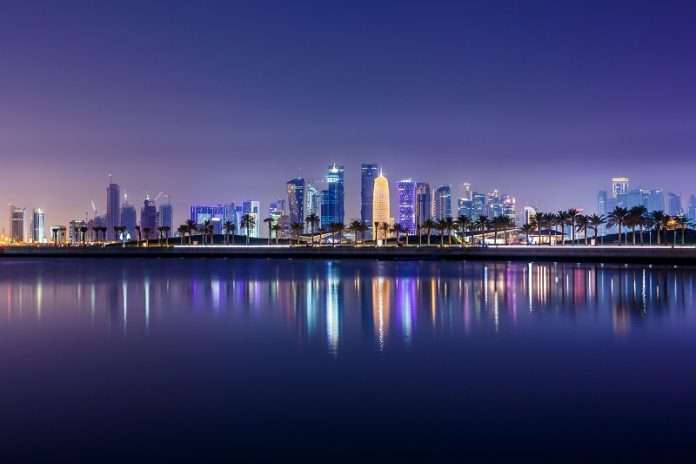Amid all the excitement of history getting scripted in Qatar with the first-ever FIFA World Cup to be staged in the Middle East, we take a breather from the beautiful game, and go behind the glitzy stadiums and the gravity-defying futuristic skyscrapers of Doha, to explore the city, as well as other attractions that the country has to offer visitors.
Qatar, a tiny nation of less than three million people living on a 12,000 km2 abutment of the Arabian Peninsula into the Arab Gulf, is often described as the ‘Pearl of the Arabian Gulf’. The country is a unique fusion of modernity and cultural tradition, with towering highrises that segue to traditional souks, from state-of-art iconic cultural and historical attractions along the coastline to a desert hinterland and undulating sand dunes that in places meet the shoreline and the sea.
Doha, the capital of Qatar, is where visitors flying in, or arriving on cruise-liners first land. The oasis-themed Hamad International Airport (HIA), lying to the east of the city and covering an area of er 22 km2, most of which is reclaimed land, provides visitors their first inkling of the country’s propensity for breathtaking architectural designs. Skytrax, a leading airport and airline review site, has accorded HIA the World’s Best Airport award in both 2021 and 2022. The airport, which caters to nearly 50 international airlines, is also home and hub for the national carrier, Qatar Airways, a seven-time winner of the World’s Best Airline award.
Meanwhile, an increasing number of visitors from around the world now arrive in Qatar on luxury cruise-liners, many of which make Doha Port a turnaround hub in their winter season itinerary. The port’s new Grand Terminal with access to dual berths is geared to cater to over 12,000 passengers per day, and also houses the region’s largest aquarium within the new City Gallery. The terminal is also designed to host open-air events on the second floor, with a large terrace stretching across the two terminals, providing an attractive year-round activity for the local community.
Moving into the city proper, what amazes visitors is the sheer number of architectural showpieces that seemingly define the city’s skyline, especially along a seven kilometer long stretch known as the Corniche. Many of the iconic buildings dotting the city appear to pay homage to the nation’s geography and past, whether it is the traditional sea-faring dhow as exemplified by the roof of the new Corinthia Yacht Club or the Sidra Hospital with its mast-shaped buildings, or a desert rose crystal, as in the case of the National Museum of Qatar. And remember, these stunning edifices were all built after 1971, when this nondescript former pearl-fishing village became the country’s capital.
Thanks to Qatar’s strategic location at the crossroads of East and West, the country is on average 6-7 hours away from key international travel hubs, with 80 percent of the world’s population within a 6-hour flight from Qatar, and with more than two-thirds of this vast populace allowed to enter Qatar visa-free. It is no wonder then that tourism and its development have been identified by the country’s leadership as one of five priority sectors integral to diversifying Qatar’s economy and to increasing private sector participation.
In 2017, the country launched the latest chapter of its five-year plan, to achieve 2030 Qatar National Tourism Sector Strategy. The plan places an enhanced end-to-end visitor experience at the heart of tourism development, and includes, among others, visa liberalization and facilitation policies, diversifying tourism along six main offerings — coastal and desert tourism, cultural tourism, business events, sports tourism, urban and family entertainment, and cruise tourism — and attracting foreign investment in Qatar’s tourism sector.
New visa policies have resulted in Qatar becoming the most open country in the region, and the eighth most open in the world according to visa openness rankings released by the UN World Tourism Organization (UNWTO) in August 2018. This high ranking reflects a string of visa facilitation measures introduced recently by Qatar, including allowing nationals of 88 countries to enter Qatar visa-free and free of charge.
Among the myriad experiences that await one in Qatar, and which are bound to pique the interest of even the most jaded of international travelers, are:

Katara Cultural Village: Open to the public since 2010, Katara is an innovative interpretation of the region’s architectural heritage, which includes impressive theaters, galleries and performance venues that stage a regular program of concerts, shows and exhibitions. The newly opened Katara Plaza includes high-end retail shops, food outlets, residential and hospitality offerings, as well as the renowned Galeries Lafayette, the chic upmarket French department store.

Souq Waqif: Founded over a century ago, Souq Waqif provides an authentic taste of traditional commerce, architecture and culture. The maze of small shops offer a dazzling array of Middle Eastern merchandise from spices and seasonal delicacies to perfumes, jewelry, clothing, handicrafts and a treasure trove of souvenir bargains. Traditional music, art and cultural shows, as well as an eclectic mix of superb restaurants and cafes add to the ambience of this special place. In 2008, the Souq went through a restoration period designed to preserve its architectural history and maintain its original elements.

National Museum of Qatar: Designed to be both immersive and experiential, the newly opened museum provides visitors with a rich environment to explore. Segmented into three chapters — ‘Beginnings’, ‘Life in Qatar’, and ‘The Modern History of Qatar’, each theme is presented across eleven highly individual galleries.

Museum of Islamic Art: Opened in 2008, the Museum of Islamic Art invites visitors to experience 14 centuries of great art in a few hours. The museum’s magnificent and imaginatively presented displays of the finest art and artifacts from across the Islamic world have earned it recognition among the world’s top cultural institutions. No visitor can fail to be impressed by the quality and diversity of the collections, housed in a modern architectural masterpiece designed by the legendary Chinese-American architectural wizard IM Pei.

Doha Corniche: The seven kilometer long waterfront promenade around Doha Bay, the Corniche offers spectacular vistas of the city, from the dramatic high rise towers of the central business district to the bold shapes of the Museum of Islamic Art. Traditional wooden dhows lining the Bay evoke echoes of Qatar’s great seafaring past. The Corniche provides a green, vehicle-free pedestrian space in the heart of the capital.

Al Zubarah Fort: A UNESCO-recognised heritage site since 2013, Al Zubarah Fort was originally built in 1938 and includes three major features, the largest of which are the archaeological remains of the town that dates back to the 1760s, when it was one of the Gulf’s most important pearl diving and trading centers with links extending to the Indian Ocean. Located on Qatar’s north-west coast, the fort is one of the most extensive and best preserved examples of an 18th–19th century settlement in the region.
Khor Al-Udeid (Inland Sea): Around 60 km from Doha in the south-eastern corner of the country lies one of Qatar’s most impressive natural wonders, the ‘Inland Sea’ or Khor Al Adaid. A UNESCO recognized natural reserve with its own ecosystem, this is one of the few places in the world where the sea encroaches deep into the heart of the desert. Inaccessible by road, this tranquil expanse of water can only be reached by traversing the rolling dunes.

No matter how or when you visit Qatar, be ready to be captivated by surroundings that meld natural beauty with architectural masterpieces, and come prepared for an unique experience in a land where the past meets the future.

















